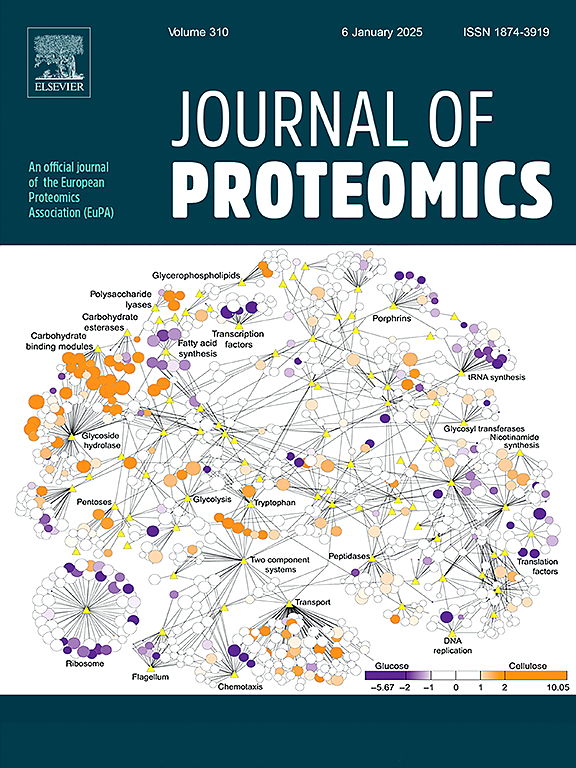Proteomics reveals genetic mechanisms of cold resistance in Hezuo pig liver tissue
IF 2.8
2区 生物学
Q2 BIOCHEMICAL RESEARCH METHODS
引用次数: 0
Abstract
Cold stress poses a significant challenge to pig farming in northern China, leading to reduced productivity and, in severe cases, even mortality. However, the mechanisms underlying cold resistance in pigs are not well understood. To explore the genetic mechanism of cold resistance in pigs under low-temperature conditions, the cold-tolerant Hezuo pig was selected as a model. DIA proteomics analysis was performed on liver tissues from Hezuo pigs after 24 h of exposure to low-temperature treatments. The results showed that approximately 149 differential abundance proteins (DAPs) were detected (95 up-regulated and 54 down-regulated). GO analysis showed that these DAPs were mainly associated with lipid metabolism, vesicle fusion, and membrane function. KEGG analysis showed that these DAPs were primarily enriched in lipid metabolism-related pathways such as cholesterol metabolism and vitamin digestion and absorption. Comprehensive analysis identified APOA4, APOA2, SREBF2, ATP23, STX2, USO1, ETFA, RAB11FIP1, ETNPPL, and SGMS1 as potential key proteins involved in cold resistance mechanisms. The mRNA expression of the genes for two key candidate proteins (APOA4 and SREBF2), which are involved in lipid metabolism, was analyzed using qRT-PCR, revealing a significant up-regulation after low-temperature treatment. These findings provide significant insights into the mechanisms of cold resistance in animals and may serve as candidate markers for further studies on cold tolerance.
Significance
Cold resistance is one of the key traits in pigs and involves multiple complex coordinated regulatory mechanisms. However, its genetic mechanisms are not completely understood. In this study, a DIA proteomics approach was used to identify proteins and pathways associated with cold resistance in the liver of low-temperature-treated Hezuo pigs. These findings offer novel candidate proteins and key pathways for investigating the molecular mechanisms of cold resistance in Hezuo pigs, providing a base for further elucidating the mechanisms of cold tolerance in pigs.

蛋白质组学揭示了河左猪肝脏组织抗寒的遗传机制。
寒冷胁迫对中国北方养猪业构成了重大挑战,导致生产力下降,严重时甚至导致死亡。然而,猪的抗寒机制尚不清楚。为探讨低温条件下猪抗冷的遗传机制,以耐寒的河左猪为研究对象。低温处理24 h后,对河左猪肝组织进行DIA蛋白质组学分析。结果显示,共检测到149个差异丰度蛋白(DAPs),其中上调95个,下调54个。氧化石墨烯分析显示,这些DAPs主要与脂质代谢、囊泡融合和膜功能有关。KEGG分析显示,这些DAPs主要富集于脂质代谢相关途径,如胆固醇代谢和维生素消化吸收。综合分析发现,APOA4、APOA2、SREBF2、ATP23、STX2、USO1、ETFA、RAB11FIP1、ETNPPL和SGMS1可能是参与抗寒机制的关键蛋白。利用qRT-PCR分析了参与脂质代谢的两个关键候选蛋白(APOA4和SREBF2)基因的mRNA表达,发现低温处理后显著上调。这些发现对动物抗寒机制提供了重要的见解,并可能为进一步研究耐寒性提供候选标记。意义:抗寒性是猪的关键性状之一,涉及多个复杂协调的调控机制。然而,其遗传机制尚不完全清楚。在本研究中,采用DIA蛋白质组学方法鉴定低温处理的河左猪肝脏中与抗寒相关的蛋白质和途径。这些发现为研究河左猪抗寒分子机制提供了新的候选蛋白和关键途径,为进一步阐明猪抗寒机制奠定了基础。
本文章由计算机程序翻译,如有差异,请以英文原文为准。
求助全文
约1分钟内获得全文
求助全文
来源期刊

Journal of proteomics
生物-生化研究方法
CiteScore
7.10
自引率
3.00%
发文量
227
审稿时长
73 days
期刊介绍:
Journal of Proteomics is aimed at protein scientists and analytical chemists in the field of proteomics, biomarker discovery, protein analytics, plant proteomics, microbial and animal proteomics, human studies, tissue imaging by mass spectrometry, non-conventional and non-model organism proteomics, and protein bioinformatics. The journal welcomes papers in new and upcoming areas such as metabolomics, genomics, systems biology, toxicogenomics, pharmacoproteomics.
Journal of Proteomics unifies both fundamental scientists and clinicians, and includes translational research. Suggestions for reviews, webinars and thematic issues are welcome.
 求助内容:
求助内容: 应助结果提醒方式:
应助结果提醒方式:


